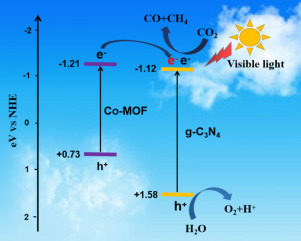当前位置:
X-MOL 学术
›
Chin. J. Catal.
›
论文详情
Our official English website, www.x-mol.net, welcomes your
feedback! (Note: you will need to create a separate account there.)
Co-MOF as an electron donor for promoting visible-light photoactivities of g-C3N4 nanosheets for CO2 reduction
Chinese Journal of Catalysis ( IF 15.7 ) Pub Date : 2020-03-01 , DOI: 10.1016/s1872-2067(19)63497-2 Qiuyu Chen , Sijia Li , Hongyi Xu , Guofeng Wang , Yang Qu , Peifen Zhu , Dingsheng Wang
Chinese Journal of Catalysis ( IF 15.7 ) Pub Date : 2020-03-01 , DOI: 10.1016/s1872-2067(19)63497-2 Qiuyu Chen , Sijia Li , Hongyi Xu , Guofeng Wang , Yang Qu , Peifen Zhu , Dingsheng Wang

|
Abstract A possible mechanism for boosting the visible-light photoactivities of graphitic carbon nitride (g-C3N4) nanosheets for CO2 reduction via coupling with the electron donor Co-metal-organic framework (MOF) is proposed in this study. Specifically, Co-MOF as an electron donor is capable of transferring the photogenerated electrons in the lowest unoccupied molecular orbital (LUMO) to the conduction band of g-C3N4 to facilitate charge separation. As expected, the prepared Co-MOF/g-C3N4 nanocomposites display excellent visible-light-driven photocatalytic CO2 reduction activities. The CO production rate of 6.75 µmol g−1 h−1 and CH4 evolution rate of 5.47 µmol g−1 h−1 are obtained, which are approximately 2 times those obtained with the original g-C3N4 under the same conditions. Based on a series of analyses, it is shown that the introduction of Co-MOF not only broadens the range of visible-light absorption but also enhances the charge separation, which improves the photocatalytic activity of g-C3N4 to a higher level. In particular, the hydroxyl radical (•OH) experiment was operated under 590 nm (single-wavelength) irradiation, which further proved that the photogenerated electrons in the LUMO of Co-MOF can successfully migrate to g-C3N4. This work may provide an important strategy for the design of highly efficient g-C3N4-based photocatalysts for CO2 reduction.
中文翻译:

Co-MOF 作为电子供体促进 g-C3N4 纳米片的可见光光活性以减少 CO2
摘要 本研究提出了一种通过与电子供体钴金属有机框架 (MOF) 耦合来提高石墨氮化碳 (g-C3N4) 纳米片的可见光光活性以减少 CO2 的可能机制。具体而言,Co-MOF 作为电子供体能够将最低未占分子轨道 (LUMO) 中的光生电子转移到 g-C3N4 的导带以促进电荷分离。正如预期的那样,制备的 Co-MOF/g-C3N4 纳米复合材料显示出优异的可见光驱动光催化 CO2 还原活性。获得了 6.75 µmol g-1 h-1 的 CO 产率和 5.47 µmol g-1 h-1 的 CH4 析出率,大约是相同条件下原始 g-C3N4 的 2 倍。根据一系列分析,结果表明,Co-MOF 的引入不仅拓宽了可见光吸收范围,而且增强了电荷分离,从而将 g-C3N4 的光催化活性提高到更高水平。特别是羟基自由基(•OH)实验在590 nm(单波长)照射下进行,进一步证明Co-MOF LUMO中的光生电子可以成功迁移到g-C3N4。这项工作可能为设计用于 CO2 还原的高效 g-C3N4 基光催化剂提供重要策略。这进一步证明了 Co-MOF 的 LUMO 中的光生电子可以成功迁移到 g-C3N4。这项工作可能为设计用于 CO2 还原的高效 g-C3N4 基光催化剂提供重要策略。这进一步证明了 Co-MOF 的 LUMO 中的光生电子可以成功迁移到 g-C3N4。这项工作可能为设计用于 CO2 还原的高效 g-C3N4 基光催化剂提供重要策略。
更新日期:2020-03-01
中文翻译:

Co-MOF 作为电子供体促进 g-C3N4 纳米片的可见光光活性以减少 CO2
摘要 本研究提出了一种通过与电子供体钴金属有机框架 (MOF) 耦合来提高石墨氮化碳 (g-C3N4) 纳米片的可见光光活性以减少 CO2 的可能机制。具体而言,Co-MOF 作为电子供体能够将最低未占分子轨道 (LUMO) 中的光生电子转移到 g-C3N4 的导带以促进电荷分离。正如预期的那样,制备的 Co-MOF/g-C3N4 纳米复合材料显示出优异的可见光驱动光催化 CO2 还原活性。获得了 6.75 µmol g-1 h-1 的 CO 产率和 5.47 µmol g-1 h-1 的 CH4 析出率,大约是相同条件下原始 g-C3N4 的 2 倍。根据一系列分析,结果表明,Co-MOF 的引入不仅拓宽了可见光吸收范围,而且增强了电荷分离,从而将 g-C3N4 的光催化活性提高到更高水平。特别是羟基自由基(•OH)实验在590 nm(单波长)照射下进行,进一步证明Co-MOF LUMO中的光生电子可以成功迁移到g-C3N4。这项工作可能为设计用于 CO2 还原的高效 g-C3N4 基光催化剂提供重要策略。这进一步证明了 Co-MOF 的 LUMO 中的光生电子可以成功迁移到 g-C3N4。这项工作可能为设计用于 CO2 还原的高效 g-C3N4 基光催化剂提供重要策略。这进一步证明了 Co-MOF 的 LUMO 中的光生电子可以成功迁移到 g-C3N4。这项工作可能为设计用于 CO2 还原的高效 g-C3N4 基光催化剂提供重要策略。











































 京公网安备 11010802027423号
京公网安备 11010802027423号